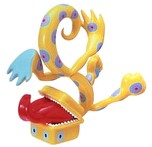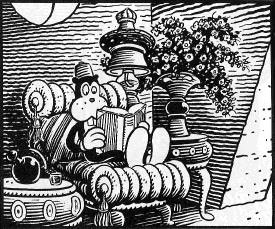
“My personal symbolic language doesn’t have meaning for everyone, not by a long shot; but when someone on the same wavelength does feel connected to my work, well, it’s a goddamn love-feast.” ~Jim Woodring
“There’s a guy named Jim, who has an affable, bearded face and draws charcoal renderings of uneasy dreams. He doesn’t draw real things, but most of the drawings are suggested by real things. This is a partial list of what seems to haunt him: frogs, chess pieces, deep-sea creatures, pigs, beetles, fetuses, early Mickey Mouse, wattles, coats of arms.” ~ Jim Ratcliff The New York Times
“Frank will take you to another world, re-arrange your consciousness and reprogram the inside of your head…” ~ Neil Gaiman
Jim Woodring has driven his volcanic imagination into a private new wonderland, and after turning a few pages, you’ll be jumping down the rabbit hole, hungry for more. Woodring began self-publishing his amazing work in 1980, and was quickly discovered by the ubiquitous Fantagraphics Company. His collection The Frank Book, was a 2003 “Booksense” top 10 Award, a Village Voice Best- of-the-Year, and he’s received standing ovations and raves from the fine art world to the back streets of Japan.
Woodring’s art has been adapted by serious Japanese animators; Visions of Frank is a collection of some of the best shorts based on Woodring’s strips. The Japanese kawaii toy craze has also produced small collectable Woodring creatures that include; “Dorbels, Jivas, Pupshaws” and tiny “Crazy Newts” popular in Japanese vending machines. A massive 350 page collection of Frank comic adventures was recently collected and reissued as The Frank Book with an introduction by Francis Ford Capolla, in which he says, “It offers vivid tableaus of tenderness and bloodshed, cruelty and sacrifice, love and betrayal, terror and bliss; and it offers them wrapped like candies from another planet.” The Frank Book has become a cult bestseller worldwide. Reading a copy is like discovering the atlas to a kaleidoscopic galaxy.
An atomic fracture and psychedelic beatitude infects Woodring’s fanciful yarns. One’s relative position in Woodring’s comic-world is never sure or safe. The true nature of animals, vegetation and reality is open to question in these colorful forests of Id and imagination.
It’s an organization of chaos within a structure of weird ethics cleverly at work. Creatures kill, explode, melt, eat each other, merge into one another or become buildings, machines, art or sculpture. Thought machines control dreams and future events. Machines can also give birth and become divine. Time and reality dance and merge in a way that can only be addressed in the kingdom of Woodring, a disciplined world of a mind opened and flowing. Flowers, food, monsters and flesh are always transforming into and out of one another. One reality becomes another, material and spiritual planes merge and recreate in an eternal, playful psychedelic dance.
Rules and authority on planet Woodring is mischevious, sacred and subversive. There are no word panels, which give it a more inter-planetary exotic feel. The only sound is in your minds eye where multi-dimensions are twisted into an alien pretzel factory. 
Woodring’s art is the perfect foil for a time of uncertainty and illusionary lifestyles. Frank is emblematic of the next-generations iconoclastic nature. The eye is captured in a pure a visual improvisation. Planet Woodring cushions and comforts us with its lovely “cuteness” (a cuteness the Japanese identify with as kawaii in Ni-hongo speak) and simultaneously “disgusts” and revolts the viewer with its often sinister malevolence, and gut-wrenching deflowerments.*
 Beside the obvious attractions to surrealism and dadaism, Woodring works in a kind of nostalgic memory vacuum. In this vast flowery comic-land of petrified innocence (or experience regained) we’re knowingly riding on waves of 60s psychedelia, the kind of paradisiacal landscape diehard LSD fans still wax poetic about.
Beside the obvious attractions to surrealism and dadaism, Woodring works in a kind of nostalgic memory vacuum. In this vast flowery comic-land of petrified innocence (or experience regained) we’re knowingly riding on waves of 60s psychedelia, the kind of paradisiacal landscape diehard LSD fans still wax poetic about.
Here is Uncle Walt’s untouchable “disneyana”, made into pop-art flesh, Fantasia blasted on brownies or a mescaline cocktails, a hallucinogenic liquid landscape. Frank’s own Mickey-mouse hands and bewildered expressions make him a cartoon “everyman”, an endearing folk hero explorer. Frank is the idyllic wasted part of us that remembers when nothing was everything, a sly commentary on the stoner psyche.
A part of Woodring’s territory is his Buddhist worldview turned into “minstrelsy.” This eternal performance of the instructive, karmic, subversive, reveals Frank as a wandering people’s minstrel. Frank appears as a flat hatted Buster Keaton, an open-mouthed Harold Lloyd and an umbrella twirling Charlie Chaplain tramp.
As physical comedian, Frank darts through panels as a sleepy-eyed sideshow vending-machine artist, a tightrope sky-walker dancing through black-holes and time warps. Devoid of language the silent-screen panels are universal fables of love, death, friendship and survival.
Frank as the wandering minstrel instructs us on how easily any world can be broken and consumed by other worlds. This is Dharmic law, where the universal is manifest. Kali Ma’s destructive forces are present, lurking around every corner, but simple tales of sharing and loyalty are equally important.  The Booksense citation of 2003 said, “Frank is an anthropomorphous character living in an alien landscape, who seeks out whatever curiosity awaits around the next turn. Like a mixture of dreamscape and nightmare, these comic strip stories can be disorienting, but learning to adjust to Frank’s world is part of the fun. The best advice is to treat the stories like a dream — they make sense in nonlinear ways. Give it 20 pages and you will be hooked.”
The Booksense citation of 2003 said, “Frank is an anthropomorphous character living in an alien landscape, who seeks out whatever curiosity awaits around the next turn. Like a mixture of dreamscape and nightmare, these comic strip stories can be disorienting, but learning to adjust to Frank’s world is part of the fun. The best advice is to treat the stories like a dream — they make sense in nonlinear ways. Give it 20 pages and you will be hooked.”
The settings in the Frank stories are akin to the fantastical and imaginative settings for fairy tales or children’s literature. There are tunnels, odd shaped houses and weird animals and vegetation around around every turn. Anything can happen in this world (and it usually does) where the usual laws of right and wrong are blurred beyond recognition. –a comicsworld.com review
In 1968, at age 13, two revelations occurred that changed Woodring’s life and led him down the thorny path of artistic no-return. One was the discovery of the intense 40s and 50s era graphic designer Boris Artzybasheff and the other was an exhibition in Los Angeles on Surrealism.
Woodring said, “I wanted to know what made Surrealism tick, to understand why one drawing had a lot of power and another didn’t. What was the ingredient that made these things run? I came to feel a good piece of Surrealism was like something that phosphoresces under ultraviolet light. You can’t see the rays, but they make it glow. I knew when that light was shining in my own head, it was just a matter of learning how to capture it.”
Opening the strange doorways of Jim Woodring is a simple joy, experienced on many levels. Enter the land of Woodring, and you’ll be changed for the better. For fanatics and knowledgeable whims, check out the Jim Woodring Monitor a blogspot by the keen “Dutch Uncle of Dreamland.” It can be tough to follow, but well worth the trouble.
 A Publisher Weekly review of Frank stated: “Woodring uses cartoon grammar brilliantly: within a single panel, he captures the round, loose style of classic animated cartoons and conjures the best of early Disney, while simultaneously acting as master engraver, with a quality of line work and elegant shading reminiscent of Gustave Dore… The mostly wordless vignettes chronicling his misadventures are actually meditations on friendship, fear, consequence and cruelty, with a mixture of pathos, humor and gore that is often disquieting. Woodring’s talent is finally captured in a definitive collection that lives up to his genius. The production and design make it an outstanding gift for enthusiasts, and it assembles all the Frank material since the 1991 debut, including covers, illustrations, trading cards and ephemera for the completist.”
A Publisher Weekly review of Frank stated: “Woodring uses cartoon grammar brilliantly: within a single panel, he captures the round, loose style of classic animated cartoons and conjures the best of early Disney, while simultaneously acting as master engraver, with a quality of line work and elegant shading reminiscent of Gustave Dore… The mostly wordless vignettes chronicling his misadventures are actually meditations on friendship, fear, consequence and cruelty, with a mixture of pathos, humor and gore that is often disquieting. Woodring’s talent is finally captured in a definitive collection that lives up to his genius. The production and design make it an outstanding gift for enthusiasts, and it assembles all the Frank material since the 1991 debut, including covers, illustrations, trading cards and ephemera for the completist.”
* for more on the the topic of Kawaii and the Aesthetics of Cute check out “Speak Up”.
Below is a link to the independent film on the life of Jim Woodring. The entire film can be seen on line here. “This elegantly profound documentary explores the award-winning, mystical work of American comics creator, cartoonist, and painter Jim Woodring. As an artist that has astounded the world for three decades, he has also suffered from hyper-realistic hallucinations and visions since he was a child – eventually diagnosed as autism and prosopagnosia (the inability to recognize familiar faces). His artwork has been lauded and collected by cultural luminaries such as Matt Groening (The Simpsons), actor Jeff Bridges (The Big Lebowski), Paul Allen (co-founder, Microsoft), and filmmaker Francis Ford Coppola (The Godfather). Audiences both familiar and unfamiliar with Woodring’s work will be fascinated by this powerful, cinematic biography which details the artist’s haunted youth and his attempts to make sense of a world that seemed less real than animated cartoons while dealing with the challenges of his autism and spiritual curiosities.”

None of these comments have anything to do with Jim Woodring. I like Jim Woodring. Alot.